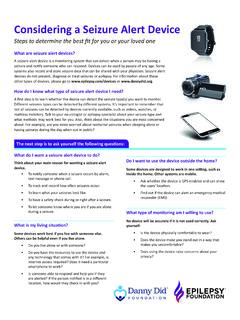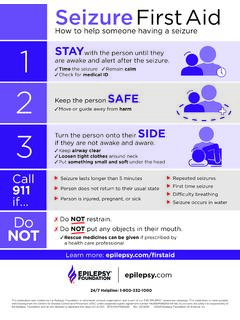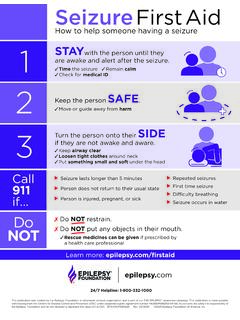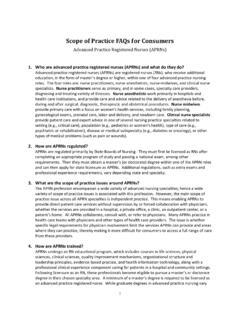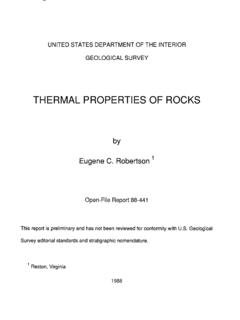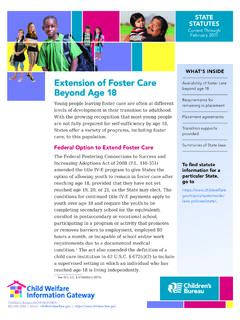Transcription of The 2017 ILAE Classification of Seizures - Epilepsy Foundation
1 The 2017 ILAE Classification of SeizuresRobert S. Fisher, MD, PhDMaslahSaul MD Professor of NeurologyDirector, Stanford Epilepsy CenterIn 2017, the ILAE released a new Classification of seizure types, largely based upon the existing Classification formulated in 1981. Primary differences include specific listing of certain new focal seizure types that may previously only have been in the generalized category, use of awareness as a surrogate for consciousness, emphasis on classifying focal Seizures by the first clinical manifestation (except for altered awareness), a few new generalized seizure types, ability to classify some Seizures when onset is unknown, and renaming of certain terms to improve clarity of attached PowerPoint slide set may be used without need to request permission for any non-commercial educational purpose meeting the usual "fair use" requirements.
2 Permission from is however required to use any of the slides in a publication or for commercial use. When using the slides, please attribute them to Fisher et al. Instruction manual for the ILAE 2017 operational Classification of seizure types. Epilepsiadoi: motorNon-Motor (Absence)Unknown OnsetMotorNon-Motorfocal to bilateral tonic-clonicGeneralized OnsetFocal OnsetMotorTonic-clonicOther motorNon-MotorILAE 2017 Classification of Seizure Types Basic Version 1 Unclassified 21 Definitions, other seizure types and descriptors are listed in the accompanying paper & glossary of terms2 Due to inadequate information or inability to place in other categoriesAware ImpairedAwareness From Fisher et al. Instruction manual for the ILAE 2017 operational Classification of seizure types.
3 Epilepsiadoi: spasms2 Non-Motor (absence)typicalatypicalmyocloniceyelid myocloniaUnknown OnsetMotor Onsetautomatismsatonic2clonicepileptic spasms2hyperkineticmyoclonictonicNon-Mot or Onsetautonomicbehavior arrestcognitive emotional sensory focal to bilateral tonic-clonicGeneralized OnsetFocal OnsetAware ImpairedAwareness Motortonic-clonicepileptic spasmsNon-Motorbehavior arrestILAE 2017 Classification of Seizure Types Expanded Version1 Unclassified31 Definitions, other seizure types and descriptors are listed in the accompanying paper and glossary of could be focal or generalized, with or without alteration of awareness3 Due to inadequate information or inability to place in other categoriesFrom Fisher et al.
4 Instruction manual for the ILAE 2017 operational Classification of seizure types. Epilepsiadoi: Seizures (start in one place)Simple (no loss of consciousness of memory)SensoryMotorSensory-MotorPsychic (abnormal thoughts or perceptions)Autonomic (heat, nausea, flushing, etc.)Complex (consciousness or memory impaired)With or without aura (warning)With or without automatismsSecondarily generalizedGeneralized Seizures (apparent start over wide areas of brain)Absence (petit mal)Tonic-clonic (grand mal)Atonic (drop Seizures )MyoclonicOtherUnclassifiable seizuresDreifuss et al. Proposal for revised clinical and electroencephalographic Classification of epileptic Seizures . From the Commission on Classification and Terminology of the International League Against Epilepsy .
5 Epilepsia. 1981;22 Classification OF Seizures 1981 Motivation for Revision Some seizure types, for example tonic Seizures or epileptic spasms, can have either a focal or generalized onset. Lack of knowledge about the onset makes a seizure unclassifiable and difficult to discuss with the 1981 system. Retrospective seizure descriptions often do not specify a level of consciousness, and altered consciousness, while central to many Seizures , is a confusing concept. Some terms in current use do not have high levels of community acceptance or public understanding, such as psychic, partial, simple partial, complex partial , and dyscognitive. Some important seizure types are not Seizure Classifications Could be Based On:PathophysiologyBut this is currently impossible withour limited understandingAnatomyTemporalFrontalParie talOccipitalDiencephalicBrainstemNetwork sNeocorticalLimbicThalamo-CorticalBrains temPractical, by.
6 AED responseSurgical targetDisablingEEG patternMany othersModify Existing1981 ILAE System2010 ILAE update In the absence of fundamental knowledge, ILAE chose to extend the existing Classification The is an operational (practical) system, not a true scientific Classification Others might devise special operational classifications for specific use, , neonatal, ICU This Classification is predominantly for clinicians Elicit symptoms and signs of event (semiology) Look for familiar patterns in symptoms and signs Sometimes use ancillary data, , EEG, MRI, genes, antibodies, Do Clinicians Classify Seizures ?Symptoms + Signs Seizure Type one-to manymany-to-oneautomatismsfocal impaired awareness seizureabsence seizureautomatismsfocal impaired awareness seizureautonomicexamplesSymptomsMedical Termautomatic behaviorsautomatismsemotions or appearance of emotions emotionsextension or flexion posturestonicflushing/sweating/piloerect ionautonomicjerking arrhythmicallymyoclonusjerking rhythmicallyclonuslanguage or thinking problems, dejavucognitivelid jerkseyelid myoclonialimpatonicnumb/tingling, sounds, smells, tastes visions, vertigosensationspausing, freezing, activity arrestbehavior arrestthrashing/pedalinghyperkinetictrun k flexionspasmKey Seizure Signs and Symptoms?
7 Allow some Seizures to be either focal or generalized onset Classify Seizures of unknown onset Clarify impairment of consciousness Include a few previously unclassified types Update word usage for greater public clarity Validate use of supportive information, EEG Conform with ICD 11 and 12 Update the 2001 glossary of seizure terms Standardize common descriptors to describe Seizures Map old to new terms The Elements of Change Allow some Seizures to be either focal or generalized onset Classify Seizures of unknown onset Clarify impairment of consciousness Include a few previously unclassified types Update word usage for greater public clarity Validate use of supportive information, EEG Conform with ICD 11 and 12 Update the 2001 glossary of seizure terms Standardize common descriptors to describe Seizures Map old to new terms The Elements of ChangeSome Seizure Onsets can be Focal or GeneralizedFocal OnsetGeneralized Onsetatonicclonicepileptic spasmsmyoclonictonictonic-clonicatoniccl onicepileptic spasmsmyoclonictonictonic-clonic Allow some Seizures to be either focal or generalized onset Classify Seizures of unknown onset Clarify impairment of consciousness Include a few previously unclassified types Update word usage for greater public clarity Validate use of supportive information.
8 EEG Conform with ICD 11 and 12 Update the 2001 glossary of seizure terms Standardize common descriptors to describe Seizures Map old to new terms The Elements of ChangeSeizures of Unknown OnsetHypothetical case: You hear a noise and enter the video-EEG room to find the patient in bed, grunting, eyes rolled up, all limbs stiff, then rhythmically jerking for a minute. He was off-camera at the start. What seizure type is this?Some seizure types are worth describing even if onset is unknown: tonic-clonic epileptic spasms behavior arrest Allow some Seizures to be either focal or generalized onset Classify Seizures of unknown onset Clarify impairment of consciousness Include a few previously unclassified types Update word usage for greater public clarity Validate use of supportive information, EEG Conform with ICD 11 and 12 Update the 2001 glossary of seizure terms Standardize common descriptors to describe Seizures Map old to new terms The Elements of ChangeKey Role of Impaired ConsciousnessAmong many possible behaviors during a seizure, impairment of consciousness has always had a key role in classifying the seizure, because of practical importance for.
9 Driving Safety during Seizures Employability Interference with schooling and learningLoss (or Impairment) of ConsciousnessTwo types of Seizures with loss of consciousnessHow well does the public understand LOC during a complex partial seizure?Elements of consciousness Awareness of ongoing activities Memory for time during the event Responsiveness to verbal or nonverbal stimuli Sense of self as being distinct from othersWhich would be the best surrogate marker? The 2017 Classification chooses awareness Consciousness remains in the classificationbut awareness is in the seizure name In several languages, these words are the same Awareness is not used to classify generalized onset seizuresLoss (or Impairment)
10 Of Consciousness Allow some Seizures to be either focal or generalized onset Classify Seizures of unknown onset Clarify impairment of consciousness Include a few previously unclassified types Update word usage for greater public clarity Validate use of supportive information, EEG Conform with ICD 11 and 12 Update the 2001 glossary of seizure terms Standardize common descriptors to describe Seizures Map old to new terms The Elements of ChangeNew generalized seizuresabsence with eyelid myocloniaepileptic spasms (infantile spasms)myoclonic-atonic ( , Doose)myoclonic-tonic-clonic ( , JME)New combined Seizures (focal to bilateral tonic-clonic)Non-Motorbehavior arrest(autonomic)(cognitive)emotional(se nsory)Motoratonicautomatismsclonicepilep tic spasmshyperkineticmyoclonictonicNew Focal SeizuresNew Seizure Types(parentheses) indicates prior existence, but renaming Allow some Seizures to be either focal or generalized onset Classify Seizures of unknown onset Clarify impairment of consciousness Include a few previously unclassified types Update word usage for greater public clarity Validate use of supportive information, EEG Conform with ICD 11 and 12 Update the 2001 glossary of seizure terms Standardize common descriptors to describe Seizures Map old to new terms The Elements of ChangeO L D T E R MN E W T E R MUnconscious (still used, not in name)Impaired awareness (surrogate)

